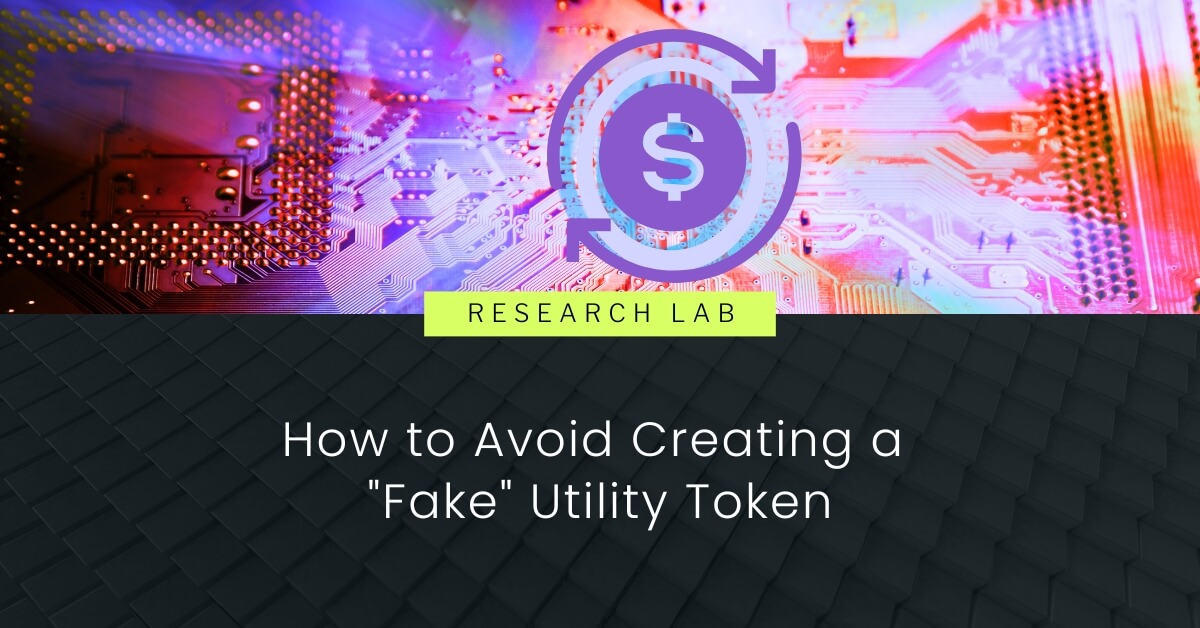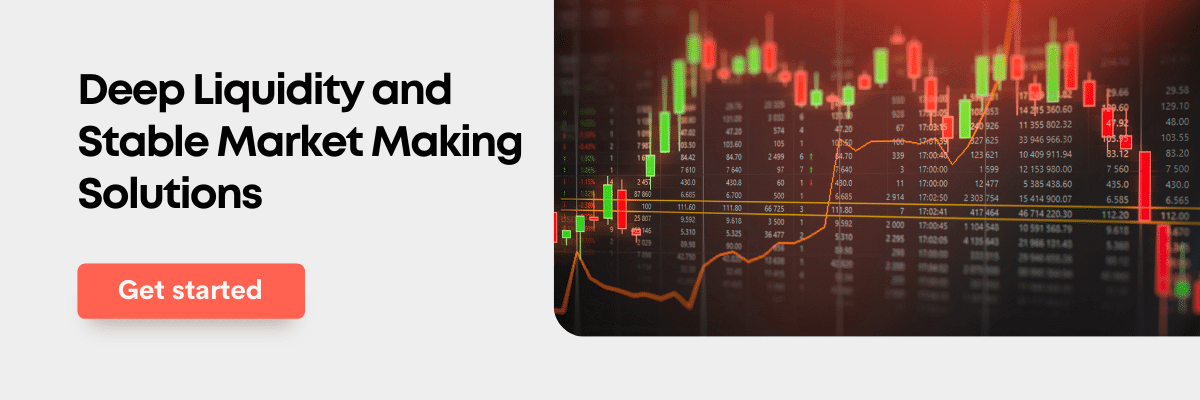Content
- Fake Utility Token vs Real Utility Token
- Why Is Staking Not A Utility?
- Why ‘Means Of Payment’ Is Not A Utility?
- Conclusion
- Contact Us
- About Zerocap
- DISCLAIMER
- FAQs
- What is a fake utility token and how can it be avoided?
- Why is staking not considered a utility in a token-based business model?
- Why is using a token as a means of payment not considered a utility?
- What are the key considerations when creating a utility token for a product?
- What are some examples of valuable adoption of the stake-to model in token-based business models?
18 Apr, 23
How to Avoid Creating a “Fake” Utility Token

- Fake Utility Token vs Real Utility Token
- Why Is Staking Not A Utility?
- Why ‘Means Of Payment’ Is Not A Utility?
- Conclusion
- Contact Us
- About Zerocap
- DISCLAIMER
- FAQs
- What is a fake utility token and how can it be avoided?
- Why is staking not considered a utility in a token-based business model?
- Why is using a token as a means of payment not considered a utility?
- What are the key considerations when creating a utility token for a product?
- What are some examples of valuable adoption of the stake-to model in token-based business models?
Every concept of a token-based business model needs to provide an answer to one basic question: what unique value does a token add to a given product? If your product would work the same without the token, or it would be even better, simpler and more user friendly, then it means that your design for token utility is not enough and it needs to be improved or the idea of creating a utility token for your product needs to be scrapped entirely. In other words, the token must be a crucial part of your product’s value proposition and narrative, and it must increase the product’s value for the end user. The token has to be embedded in the ‘product story’ which is being told to your future users and potential investors.

Fake Utility Token vs Real Utility Token
In the decentralized finance (DeFi) sector, token-based business models have become a popular method. In this paper, we propose a typology of token-based business models in DeFi, based on their value proposition. There are two types of token-based business models that can be identified: those that add value to the product, and those that do not. The former type enhances the product through the inclusion of the token, while the latter type does not provide any added value or may even lead to a reduction in product quality after token implementation. Understanding the differences between these two types of token-based business models can help in the development and evaluation of DeFi projects.
In some cases, the inclusion of a token in a product can be viewed as a forced effort, where the token is connected with seemingly functional utilities that are actually separate and irrelevant to the product itself. This is an example of fake utility, which is often observed in token-based business models that do not add value to the product. Two common examples of fake utility are staking, and the use of the token as a means of payment. Understanding the concept of fake utility and the potential negative effects of implementing a token without true value can inform the development and evaluation of token-based business models in the DeFi sector.
Why Is Staking Not A Utility?
Staking as a standalone product is based on accepting a deposit of your token and giving rewards for it. If this is the only added value of the staking model you’ve adopted then it has no relevance or meaning to your product and is functionally separated from your business model. From an economic perspective, it is just taking ‘money’ from the community and slowly giving it away. Considering the above, staking is not and will never be a stand-alone token utility.
With that being said, it can still be effectively combined and act in great synergy with other utilities as a so-called stake-to model, meaning that the user needs to stake at least [x] amount of tokens to unlock specific bonuses of features related to the product. Again, if the only bonus is a rewards multiplier, then it would still be fake utility.
An example of valuable adoption of the stake-to model is using it to prevent DoS and Sybil attacks. Protocols can implement a prerequisite of staking a small number of tokens to interact with a product in order to protect a user from a massive bot-generated activity like fake posts, movement, referrals, upvotes, likes etc. Another example is offering some of your products and services for a cheaper price (or reducing commission fees applied on trades made through your platform) for users with at least [x] token staked.
Why ‘Means Of Payment’ Is Not A Utility?
Imagine a user goes to their greengrocer’s to pick up some vegetables. The user then wants to pay for those vegetables. The user takes out their wallet, but the cashier tells them that they do not accept any Fiat currency. Instead, the user can only pay for the items with the shop’s equity. If the user does not hold any equity in the greengrocer, the user can simply buy the equity with Fiat currency, and then sell the equity in exchange for the vegetables they wanted. If this wasn’t a UX disaster already, the user cannot buy the equity shares directly in the shop. Instead, they will have to go to an exchange and get charged an additional commission for buying the shares. Throughout this whole process, the exchange is extracting value from the customer through the form of transaction fees.
The above concept might sound grotesque, but in fact, the very same approach is being used by the majority of token-based business models, calling it ‘token utility’. Using a volatile, fungible token as a means of payment for service originates from how first blockchains with smart contract functionality worked. For example, ethereum uses ETH (also called Ether) as means of payment for interacting with the blockchain (e.g. sending ERC-20 assets from one wallet to another).
On the contrary, using a blockchain native coin to cover the cost of interacting with it makes perfect sense and is tied to the very nature of how blockchain works and its underlying node-based infrastructure. Interacting with blockchain cannot be free as nodes need to be rewarded for maintaining the nodes (hardware) keeping the chain up and running. It would also make no sense to connect blockchain with a stablecoin-based economy, since the spirit of DEFI and blockchain-based assets is about escaping centrally-managed economies and limiting counterparty risk.
Asking your target users to pay for your product or service using your token is akin to asking them to purchase your equity shares and return them, much like the example of the greengrocer mentioned earlier. This is particularly true in business models where revenue is tied to transaction volume. If this is the sole payment method, it can also be seen as imposing financial risk on your users by exposing them to highly volatile assets.
Conclusion
The value proposition of a token-based business model must be clear and provide unique value to the end user. The inclusion of a token must enhance the product and not be a forced effort. Two types of token-based business models can be identified: those that add value to the product and those that do not. The latter can lead to fake utility and a reduction in product quality after token implementation. Staking, as a standalone product, does not provide true value to the end user, but can be effectively combined with other utilities in a stake-to model. Similarly, using a token as the exclusive means of payment for a product can discourage non-crypto users from making a transaction and expose users to additional costs and price volatility risks. Token-based business models should aim to provide a broader value proposition beyond just using a native token as a payment method.
Contact Us
In case you’re interested in purchasing one of our due diligence and consulting packages or would like to get more details on the above, feel free to reach us via [email protected] or [email protected]. You can also contact us directly through one of the following telegram IDs:
- @d_dum – QuantBlock’s CEO
- @nathanZC – Zerocap’s Innovation Lead
About Zerocap
Zerocap provides digital asset investment and digital asset custodial services to forward-thinking investors and institutions globally. For frictionless access to digital assets with industry-leading security, contact our team at [email protected] or visit our website www.zerocap.com
DISCLAIMER
This article, authored by QuantBlock, is published on Zerocap’s website for informational purposes only. The content, views, and opinions expressed in this article are solely those of QuantBlock and do not represent or reflect the views, opinions, or positions of Zerocap. The information provided should not be considered financial advice, and Zerocap bears no responsibility for any actions taken based on the article’s content.
Zerocap does not guarantee the accuracy, completeness, or timeliness of the information provided in the article. The industry sector discussed is subject to rapid changes, and the content should not be regarded as universally applicable or definitive.
For any concerns about the article’s authenticity, please contact QuantBlock directly at [email protected].
FAQs
What is a fake utility token and how can it be avoided?
A fake utility token is a token that is connected with seemingly functional utilities that are actually separate and irrelevant to the product itself. To avoid creating a fake utility token, the token must be a crucial part of your product’s value proposition and narrative, and it must increase the product’s value for the end user. The token has to be embedded in the ‘product story’ which is being told to your future users and potential investors.
Why is staking not considered a utility in a token-based business model?
Staking as a standalone product is based on accepting a deposit of your token and giving rewards for it. If this is the only added value of the staking model you’ve adopted then it has no relevance or meaning to your product and is functionally separated from your business model. However, it can still be effectively combined and act in great synergy with other utilities as a so-called stake-to model, meaning that the user needs to stake at least [x] amount of tokens to unlock specific bonuses of features related to the product.
Why is using a token as a means of payment not considered a utility?
Using a volatile, fungible token as a means of payment for service originates from how first blockchains with smart contract functionality worked. However, asking your target users to pay for your product or service using your token is akin to asking them to purchase your equity shares and return them. This is particularly true in business models where revenue is tied to transaction volume. If this is the sole payment method, it can also be seen as imposing financial risk on your users by exposing them to highly volatile assets.
What are the key considerations when creating a utility token for a product?
The value proposition of a token-based business model must be clear and provide unique value to the end user. The inclusion of a token must enhance the product and not be a forced effort. Token-based business models should aim to provide a broader value proposition beyond just using a native token as a payment method.
What are some examples of valuable adoption of the stake-to model in token-based business models?
An example of valuable adoption of the stake-to model is using it to prevent DoS and Sybil attacks. Protocols can implement a prerequisite of staking a small number of tokens to interact with a product in order to protect a user from a massive bot-generated activity like fake posts, movement, referrals, upvotes, likes etc. Another example is offering some of your products and services for a cheaper price (or reducing commission fees applied on trades made through your platform) for users with at least [x] token staked.
Like this article? Share
Latest Insights
On-chain Bitcoin Metrics: The Main References
In the realm of cryptocurrency investment, on-chain Bitcoin metrics provide a critical lens through which investors can gauge market conditions and make informed decisions. These
What is the Base Blockchain? The Coinbase Layer 2
The Base blockchain, introduced by Coinbase, represents a significant development in the realm of cryptocurrency and blockchain technology. It is a layer-2 solution built on
Bitcoin Mining in the US: Main Challenges
Bitcoin mining in the United States has recently faced a range of challenges, from regulatory hurdles to community and environmental concerns. As a significant hub
Receive Our Insights
Subscribe to receive our publications in newsletter format — the best way to stay informed about crypto asset market trends and topics.



 Share
Share  Tweet
Tweet  Post
Post 